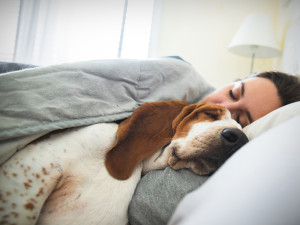It’s Time to Fall Back—How Daylight Saving Time Will Affect Your Pet
It’s confusing to them, too.
Sunday, November 2 is the end of daylight saving time. That means we need to set our clocks back an hour so we can get some morning sunlight — and yes, this is the one when you gain an hour of sleep (yay!). Not everyone will change their clocks, though. While most of the country observes this ritual, in Arizona, only people who live on the Navajo Nation change their clocks. Those in Hawaii and Puerto Rico don’t participate, either.
But if you are in that majority and also happen to be a pet parent, now’s the time to prepare yourself for this semi-annual frustration. Many people consider daylight saving time to be an unhealthy human construct — and animals are having no part of it. Dogs and cats simply follow their circadian rhythms.
What is circadian rhythm?
Just as birds chirp at sunrise and coyotes howl during the night, our pets are inclined to be active during different times of the day. The tendency to behave in certain ways over the course of the day is part of the daily cycle called a circadian rhythm.
These internal clocks override our rigid time schedules, so many dogs (and many more cats) will likely start their day at their usual time, regardless of what the clock says.
How much do you spend on your pet per year?
The light/dark cycle of our rotating planet is responsible for the circadian rhythms that lead to the predictable timing of behaviors throughout the day. Light leads to changes in the hypothalamus, which regulates these daily rhythms. The pattern of light affects sleep cycles, brain wave activity, hormone levels, and body temperature, all of which impact behavior.
Helping your pet adjust to the time change
When the time shifts, dogs and cats are typically confused — and unfortunately, we have no way to explain the tradition to them. But there are a couple of ways you can help your pet adapt:
Keep a routine.
It’s typical for pets to need a couple of days to adjust after the time change, but some take longer than others. Pets with a strong internal clock are heavily influenced by sunrise, sunset, and predictable feelings of hunger. As those cues still happen, pets who respond to them tend to struggle with the new schedule.
Some dogs are also highly schedule-oriented, but they respond to human cues — the alarm clock, people getting out of bed, the sound of food being put in the bowl — and they are often able to adapt more quickly to the wackiness of humans messing around with clocks.
Take it slow.
It can be helpful to meet pets in the middle as they adjust to the time change. It may be easier if you can break up the hour difference and only adjust their schedule — walks, feeding time, bedtime and waking up — by 15 to 30 minutes each day. If your schedule does not allow that kind of flexibility or you find that your dog gets in line with the new daily rhythm within a few days anyway, it may not be worth the extra effort. But, for the rare dog who struggles for a long time with the time change, breaking up the hour into smaller pieces for a more gradual adjustment can be a great kindness.
It can be tough for some pets (and let’s be real, for some people too) to adapt, so build in room for an adjustment period. Giving them a few extra minutes to take care of business might be all it takes to get them acclimated to the abrupt change in schedule.








